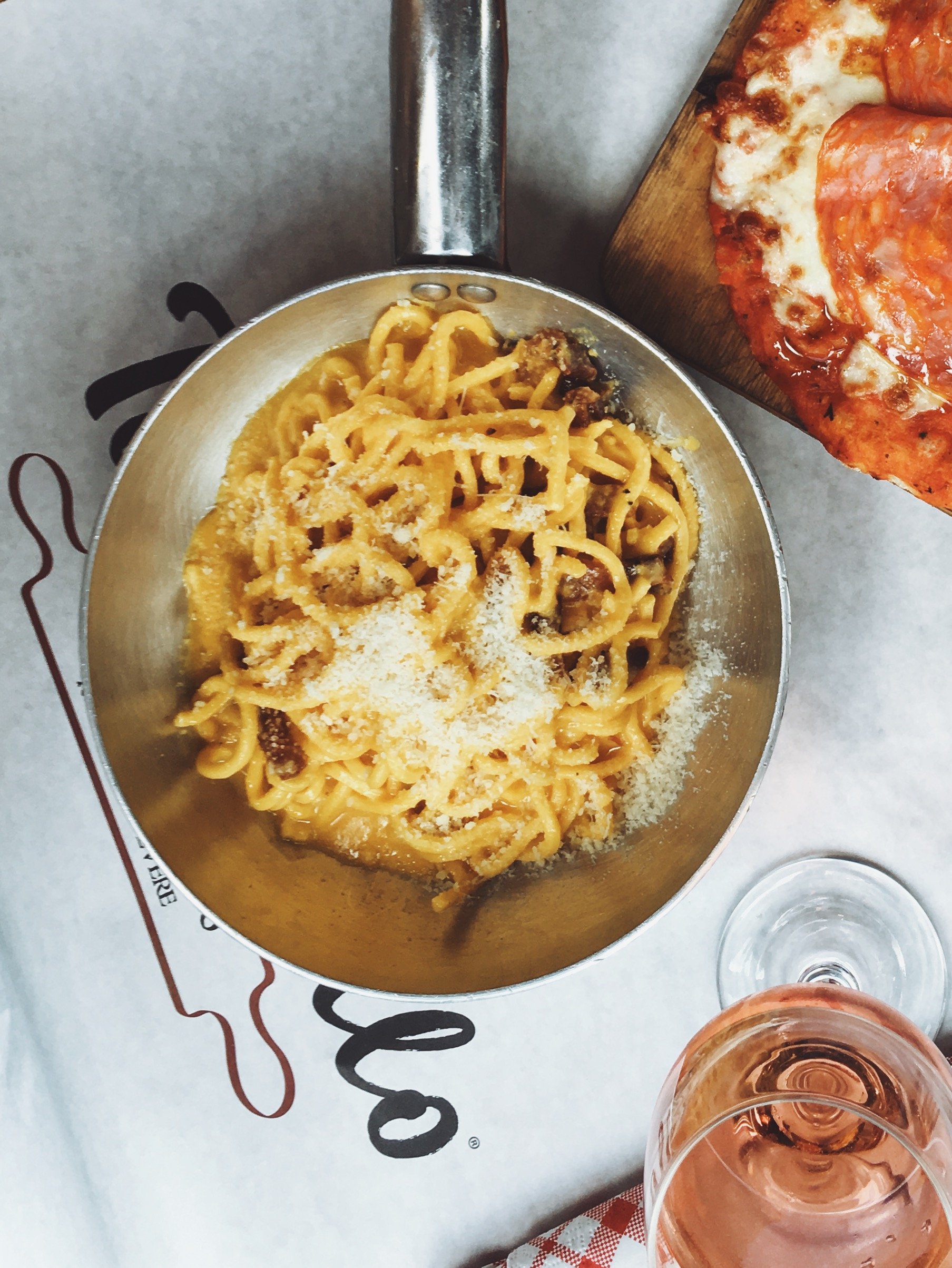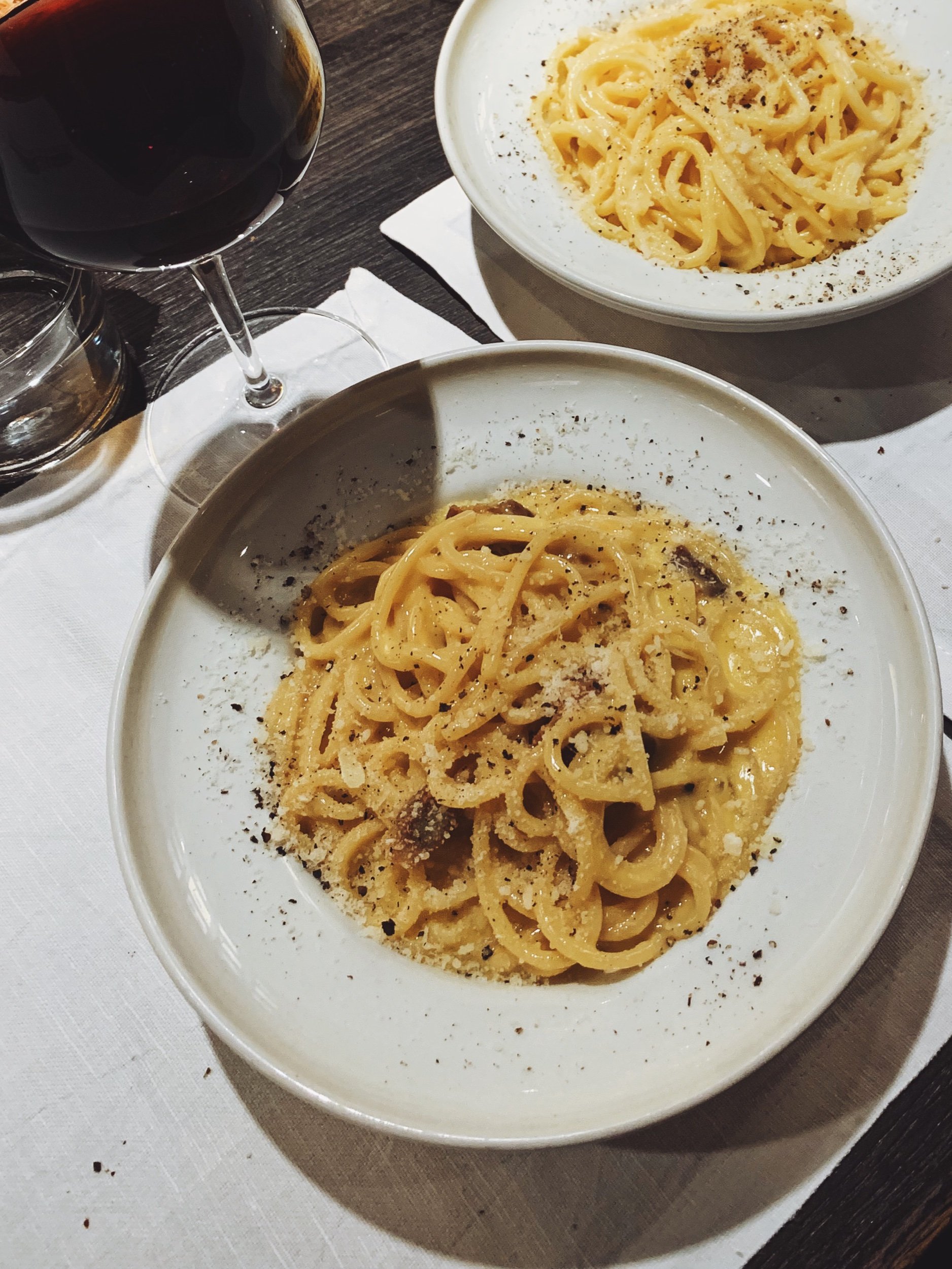perfect carbonara
I'm not a person who tends to repeat things. I don't re-read books. I don't re-date exes. Every couple of years I watch Pulp Fiction but that's different. But holy mother of god I have made so much carbonara trying to get this right and it finally paid off.
Carbonara is notoriously one of the toughest “simple pastas” to execute. Even at restaurants, the line between silky and spongy is only ever a distraction away from being crossed. As a result, I only order carbonara at restaurants that specialize almost exclusively in carbonara prep. I've been disappointed even then.
Then I went to Rome, the carbonara kingdom of the world, and got schooled. Here is all the USEFUL advice, some new, some not, from my people to yours:
Choose a suitable pasta shape! I personally love bucatini, but rigatoni is also great here. Spaghetti will work. You want something sturdy, with good chew.
Use more yolks—and fresh eggs. Seriouseats has written about this in the past, preferring a 3:1 ratio. With so few ingredients, and the eggs receiving such minimal cooking, ultra fresh eggs will give the best flavor.
Seek pecorino. The sheepy sharpness of pecorino is what cuts through the egg fat. I love pecorino. It is in no way redundant with parm. Buy pecorino! You can even combine them, if you want, but pecorino should be primary.
Cube your cured meat and tender it slowly. Fat, small cubes are perfect for this. A lot of American stores only sell sliced pancetta. In this instance, you can cut it into strips. Searing this without oil releases some of the fat quickly, which you can then use to finish cooking it slow and low. No excess grease!
Mix the eggs, pepper, and cheese FIRST. This was my breakthrough. I add the cheese to whisked eggs in a silicone measuring cup and an estimate of the pepper. This helps create a totally even combination so that you are NOT trying to mix the ingredients on the stove, which will take too long and will inevitably scramble the egg.
Take a break—then use looooow, direct heat. Pull the pork off heat, then wait while you finish the pasta to very-nearly edible al dente. Then, combine the pasta straight into the pancetta and turn the heat back onto the lowest possible heat. Toss these together first with a splash of pasta water, then add the egg mixture. This is a good time to use a burner that is not your power burner.
Toss FAST. Once the pasta, pancetta + its fat, and pasta water are heating over low heat, add the egg mixture you made and start mopping it up with pasta. The goal is to toss this extremely quickly—the ambient heat of the pan is going to cook the egg in about 30 seconds to a minute.
Do. not. add. anything. else. to. this. recipe. Romans are precise people, SO NO GARLIC. NO CREAM. NO BUTTER. NOOOO PARSLEY. None of these things improve this dish.
RECIPE
The perfect, authentically Roman carbonara is out there—and you don’t have to go to Rome to get it. With just four basic ingredients (five if you count pepper) and a tiny bit of practice, you can create a restaurant-level pasta alla carbonara in your kitchen that won’t piss off anybody’s grandmother.
Effortful time: 10 minutes
Total time: 30 minutes
Serves 2-3
YOU NEED
12 oz of pasta (I like bucatini or rigatoni best), plus reserved water
4 oz pancetta, cubed (can use guanciale if you can find it)
3 large egg yolks (whites discarded) + 1 large egg (yolk and whites)
1/3 cup grated pecorino romano
A LOT of coarsely ground black pepper — you can adjust this to taste, but I use about 30 heavy twists on the coarsest possible grate
Salt, for the pasta water
MAKE IT
Cook the pancetta. Heat a skillet over medium-high heat and add your pancetta. Sear this until it releases naturally from the pan and starts to produce fat. Then turn the heat down to low, and cook low and slow to render all the fat (which the pancetta will continue cook in) until the pancetta is fully crispy but not burnt or charred, about 10-12 minutes for cubes. Turn off the heat and leave it on the stove.
Cook the pasta. Bring water to a boil in another skillet over high heat. Salt it. Once your pancetta is cooked, add the pasta. The shallow pan is deliberate — it makes a more concentrated starch-water at the end, which you need to bind the eggs.
Prep the egg mixture. In a measuring cup, combine the full egg, the separated egg yolks, the cracked pepper, and the pecorino cheese and whisk into a gritty slurry. Because the eggs and cheese are now mixed together, they will both emulsify on contact with the starchy water, creating a smooth sauce.
Transfer the pasta into the pancetta pan. When pasta is very nearly done (taste it — it should be an edible al dente, since it won't have much more time to finish), turn off the heat on your pasta skillet and use tongs to pull it from the water and into the pancetta pan. Use a cup to add a splash of the pasta water from the pot into the pan. Use your tongs to loosen the tangles in the pasta (if you undershot the cook time, this can help you close the gap a bit before you add the egg) and coat the pasta evenly with the fat from the pancetta.
THE BIG STEP: toss it all together. Turn the cooled skillet with the pancetta and pasta back to LOW heat. Then, working very quickly, pour the egg/cheese/pepper mix on top of the pasta, minimizing its contact with any part of the pan's surface. Then toss! Toss toss toss. Lots of swirly, swishy hand movements, like you’re mopping the pan with the pasta pile. The goal is to never let it rest for too long, as this scrambles the eggs. You should do this for approximately 20 seconds up to a minute until the sauce emulsified and tightens around the noodles and is thick, not drippy, when you pull the pasta upwards. Feel free to add a splash more pasta water if things start to get too thick.
Serve it up. Pull from the heat and immediately portion into bowls — carbonara does not improve as it sits around. Give each a little extra pecorino shower and another crack or two of black pepper.




